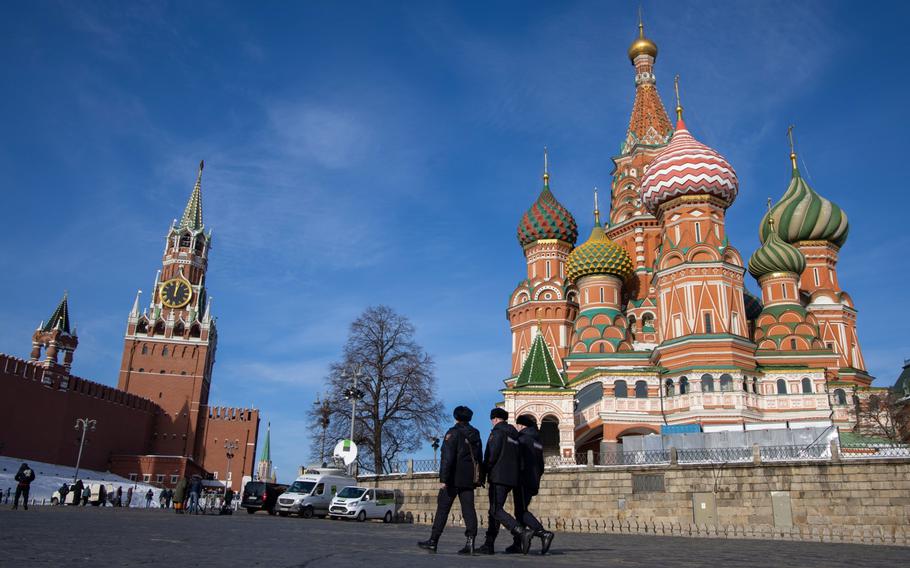Europe
Russia’s yearslong quest to quit dollar eases impact of sanctions
Bloomberg February 24, 2022

Police officers patrol Red Square, near the Kremlin, in Moscow on Feb. 15, 2022. (Andrey Rudakov/Bloomberg)
RUSSIA-DOLLAR-BG 854 words · 1 photo Russia’s yearslong quest to quit dollar eases impact of sanctions (c) 2022, Bloomberg · Payne Lubbers, Sydney Maki, Selcuk Gokoluk · BUSINESS, WORLD, US-GLOBAL-MARKETS · Feb 24, 2022 - 11:10 AM Russia’s multi-year push to remove the dollar’s hold over its economy and financial markets has so far helped ease the impact of sanctions from the U.S. and its allies, even as they prepare tougher measures that could test the extent of a true de-coupling from the greenback.
The nation slashed its dollar reserves to just 16% of the central bank’s stockpile in 2021, down from more than 40% just four years prior. That’s meant aggressively hacking its holdings of U.S. Treasuries, shrinking ownership by almost 98% from a peak in 2010 and removing dollar assets from its sovereign wealth fund.
These moves will now help insulate Russia from some of the worst fallout of escalating U.S. and European sanctions after President Vladimir Putin began a full-scale invasion of Ukraine. While sanctions so far prevent the nation from tapping international investors, with the U.S. prohibiting new purchases in the secondary market from March, efforts to make Russia less dependent on the dollar could blunt their impact and potentially buy Putin time to withstand even more stringent sanctions, at least for a while.
Further penalties -- such as limiting Russia’s access to Swift, a messaging platform integral to international orders and payments -- could prove far more costly and prompt an even more severe reaction in global markets, but such options have divided politicians in Europe and the U.S.
“Russia has taken considerable steps to diversify away from the dollar,” said Ehsan Khoman, head of emerging-market research for Europe, Middle East and Africa at MUFG Bank in Dubai. “That has led to a degree of resilience, though full-blown economic sanctions is triggering meaningful market volatility and a recession should not be overlooked.”
Of course, it is nearly impossible for Russia to part from the dollar completely. The nation’s primary exports are oil, petroleum products and natural gas -- all conventionally traded by global markets in the greenback.
Some Russian oil exports contracts are, however, traded in euros now. And with the attack on Ukraine pushing an already-soaring crude price above $100 per barrel, Russia may have less need to access foreign financial markets anyway, according to Paresh Upadhyaya, director of currency strategy at Amundi Asset Management.
“The Russians don’t really need to issue bonds,” he said. “There is zero chance of a balance-of-payments crisis when you combine their FX reserves with their wellbeing fund.”
The Bank of Russia estimates the country’s January current account surplus reached a record high of $19 billion, having more than doubled from the same period in 2021. Its National Wellbeing Fund -- an oil-funded sovereign-wealth fund that forms part of Russia’s reserves -- oversees more than $170 billion; since June 2021, it’s held no dollars.
This is far from Russia’s first run in with sanctions from other major economies. After its annexation of the Crimean peninsula from Ukraine in 2014, Russia was suspended from the Group-of-8 political forum, and certain Russian citizens and companies were sanctioned.
That’s encouraged Russian policymakers to shift the economy away from being so dependent on the dollar, including moves to settle more international transactions in other currencies. In 2020, the euro overtook the greenback as the primary currency to price Russian exports to China, which has become one of the country’s key trading partners. Just this month, state-owned gas producer Gazprom Neft said it would only accept the yuan for fueling Russian airplanes at China’s airports.
Indeed, the dollar’s share of Russian export receipts declined from 69% in 2016 to 56% in the first half of 2021, while the euro’s doubled to 28%, according to a study by UBS Group economist Anna Zadornova.
But other ways to penalize Russia are still open to the U.S. and others, de-dollarized economy notwithstanding. Restricting access to Swift, which handles payments in many different currencies, could cause serious pain. While Bank of Russia has a messaging system that could be used as a potential replacement for Swift, it’s only in limited use currently. When Russia’s access to Swift was threatened in 2014, Alexei Kudrin, a onetime finance minister close to Putin, estimated that it could reduce Russia’s gross domestic product by 5% in a year.
“There is still the risk of exclusion from Swift,” said Manik Narain, head of emerging-market cross-asset strategy at UBS. “While Russia has been working to reduce its vulnerability to that, it could still be a large negative economic shock.”
Major oil firms could also become targets for sanctions, making it difficult to carry out transactions.
Still, short of more drastic steps, investors see Russia as capable of standing up to the sanctions.
“Russia has insulated itself from global markets,” said Simon Harvey, head of FX analysis at Monex Europe Ltd. “It has learned the lessons of the past 10 years and positioned itself for this eventuality. But there is the risk that now sanctions have to be a lot broader to impact the economy -- I think that is why you are seeing this market reaction.”
Bloomberg’s Alex Nicholson, Anya Andrianova, Olga Tanas, Evgenia Pismennaya and Aline Oyamada contributed to this report.